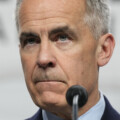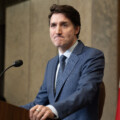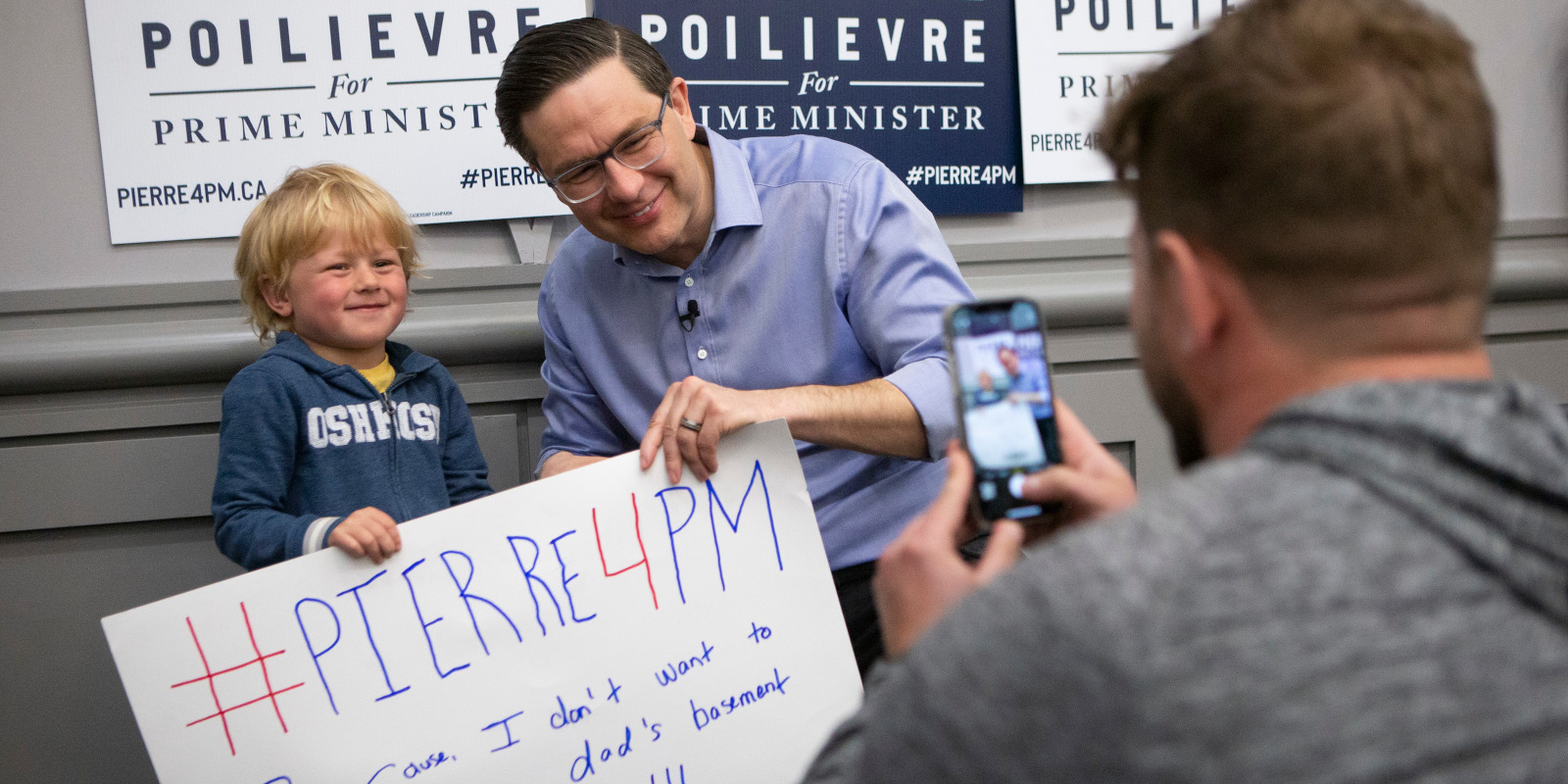Is Pierre Poilievre Canada’s first “influencer” politician?
Influencers are online celebrities with large social media followings that promote anything from sneakers to lip gloss to hunting products, with the intent of convincing their audiences to buy them.
The products that influencers promote are often niche and appeal to a specific audience. Poilievre does not promote $975 sneakers, but he is certainly selling promises and principles.
Long popular with the Conservative base for his stern questioning and rhetorical attacks on the Liberal government, Poilievre’s brand skyrocketed during the party’s leadership race following Erin O’Toole’s ousting in February.
YouTube is a favoured outlet for Poilievre. He has released dozens of short to medium-length videos on the platform and received millions of total views. The videos are marked by grabbing slogans like “Remove Gatekeepers” and “Justinflation”, targeting issues affecting Canadians like the rising cost of living, or more specific topics like delays at Toronto’s Pearson Airport.
Ginny Roth, who is the national practice lead for government relations at Crestview Strategy and who worked on Poilievre’s leadership campaign, says Poilievre’s audience is far too broad to be properly classified as an influencer.
“Where influencers are looking to sell something to a niche group of people through a marketing channel…Poilievre is trying to build a movement that’s really broad,” says Roth. “He’s doing it through a variety of different channels, and he knows that a lot of Canadians are on social media, and they’re casual users…they’re not niche expert users.”
Others have different opinions.
In March, Ben Woodfinden, Poilievre’s freshly-hired director of communications, and former Hub contributor, described the then-Conservative leadership frontrunner as having an “influencer kind of vibe”.
“In many ways, yes, there’s an influencer part to his discourse,” agrees Vincent Raynauld, associate professor of communications at Emerson College in Boston, Massachusetts. “But there’s also a populism part to his discourse, and I think this is where social media is really pushing politicians to become ever more populist in their approach to political communication.”

Poilievre is frequently described as a populist, an assessment Raynauld agrees with, but notes that the Conservative leader is not alone in his approach.
“When you talk to folks, they often associate populism (with) your political ideology, but increasingly you can look at populism as a form of political communication,” says Raynauld. “An everyday, charismatic person talking about associating themselves with the people, and so making sure that they connect on a more personal level.”
In the recent U.S. midterm election in Ohio, Democratic senate candidate Tim Ryan released a video of himself throwing footballs at television screens showing the phrase “Defund the Police”, and politicians who Ryan accused of signing bad trade deals with China and selling out Ohio workers.
This contrasts with more conventional campaign ads from 10 years ago produced by other U.S. politicians, like Republican presidential nomination contender Rick Perry, who stood in front of a camera to outline his political principles in a 30-second, single-take monologue.
According to Raynauld, Poilievre is also bringing politics back to what Raynauld refers to as “kitchen table politics.”
Fittingly, Raynauld points out a Poilievre video titled “Breakfast with Justin”, where Poilievre eats breakfast at a diner while listing the rising costs of his meal due to inflation.
“He’s really trying to connect on a more personal level with members of the public and he’s trying to take a more informal way to reach out to the people,” says Raynauld.
Raynauld mentions another video where Poilievre tours his childhood neighborhood in Calgary, and how his upbringing made him well-suited to become prime minister.
“These are all things that I think are meant to be personal, they are meant to be, in some ways, private,” says Raynauld. “They are really meant to foster this sort of intimate connection between the social media user on one end and Pierre Poilievre on the other.”
Poilievre is a controversial politician due to his promises to fire Bank of Canada governor Tiff Macklem, defund the Canadian Broadcasting Corporation, and most recently, his critiques of drug-addiction policies in British Columbia.
Furthermore, Poilievre’s lack of engagement with members of the parliamentary press gallery in Ottawa, in favour of reaching out to smaller community papers read predominantly by Canada’s many immigrant communities, has led to additional criticism.
Writing in the Toronto Star, commentator Chantal Hébert asserted that Poilievre’s momentum has stalled due to his communications strategy of avoiding the press gallery and unfavourably compared him to former Conservative leaders who made more time for mainstream media outlets.
Poilievre is routinely criticized or praised in traditional newspapers, but Roth says those publications’ influence has declined since their heyday.
“People get their news and information and content from a variety of sources now, and they don’t inherently trust the mainstream media in a way that they used to,” says Roth.
Recent surveys suggest Canadians’ trust in the “mainstream media” has declined to historic lows of 42 percent in recent months.
Susan Smith is the co-founder of Bluesky Strategy Group with experience working on Liberal Party campaigns.
“People are influenced by their families and peer groups, and by others in the social media and news funnels that they live in,” says Smith. “The traditional media are just one voice in the cacophony that accompanies a campaign.”
Smith says that if the endorsements of traditional publications do have an effect, it is only towards the end of the general election, and among older demographics.
While Poilievre’s videos don’t necessarily attract millions of views on an individual basis like a celebrity or influencer, they are far more popular than the average Canadian politician’s media output.
For example, among Justin Trudeau’s twelve most recent videos published on the prime minister’s official YouTube channel, the most viewed video garnered less than 8,000 views. By comparison to Trudeau’s channel, Poilievre’s most viewed video among his last twelve released, titled “The Message”, has been viewed just shy of 100,000 times. Others, though, like his leadership campaign launch video, have reached numbers well into the hundreds of thousands.
“Poilievre is unencumbered from the responsibilities, realities, and the experience of governing so has more time to film rants on his topic-du-jour,” says Smith. “Less scripted is better for Trudeau. I expect you’ll see more of that in the weeks and months to come.”
The Liberal Party’s official YouTube account’s videos typically garner a similarly low view count to Trudeau’s.
“I think people are now their own curators of what’s true, and what’s interesting, and that’s compelling to them,” says Roth. “The benefit of that is that people with a strong message don’t need to be filtered through those outlets necessarily, they can speak to people directly on social media.”
Raynauld says the use of social media in political communication has radically changed over the last two decades, listing the campaigns of viral U.S. political figures like Howard Dean in 2004, Barack Obama in 2008, and Donald Trump in 2020 as exemplifying instances of this shift.
Of those three candidates, only Dean never became president. Raynauld also singles out 2006 as a Canadian election year where personal blogs became prominent in Canadian politics, contributing to the change in communications.
YouTube itself launched in 2005, providing a popular platform for video blogs, better known as vlogs.
“Campaigning has really evolved over the past years, and I really think that Pierre Poilievre probably is one of the few first ones in Canada that has adopted more of an informal tone when it comes to the approach to political campaigning online,” says Raynauld.
Poilievre is not the only federal party leader attempting to harness the power of social media to grow their presence.
New Democratic Party leader Jagmeet Singh frequently uses Tik-Tok as a platform to try and connect with younger voters by taking part in dance trends, and also shared a Twitch stream with prominent American progressive Democrat Alexandria Ocasio-Cortez.
However, Singh’s strategy appears to have had little effect on his party’s fortunes, with the NDP making only marginal gains in the last election.
“I think Mr. Singh is really mimicking trends and other people are innovating, and that gives him some reach, but not the same kind of reach as Mr. Poilievre,” says Roth.
Noting that Singh’s Tik-Toks backfired, Smith says Poilievre’s strategy is effective at targeting politically conservative and youthful demographics, with some surveys suggesting the latter prefer the Poilievre-led Conservatives.
Yet Smith says that by taking a non-traditional route, Poilievre, like Singh, is missing out on communicating with large swathes of the public who want to see him tested outside his bubble.
“Poilievre is giving lots of voters an opportunity to explore on their own time whether they like or dislike him,” says Smith.
Raynauld says that people have different expectations for traditional print media and more modern mediums like YouTube.
“When you open up a newspaper…you have different expectations than for example, when you are on the metro…and you open up your Facebook account, or you open up your YouTube account, and you start looking at videos that have been posted by politicians,” says Raynauld.
Roth states Poilievre is not the first politician to utilize social media, saying the federal Liberals have successfully used targeted paid advertising on Facebook during general elections.
Prior to his ouster, Erin O’Toole also published videos on his YouTube channel to try and connect with voters but reached vastly smaller audiences.
“What makes the Conservative leader (Poilievre) different is he, I think, has understood from day one that the kind of content that people engage with in a YouTube environment is just good content,” says Roth. “That sounds simplistic, but good communication [is using] compelling communications that actually deliver a message that people can connect with, and speaks to real concrete issues with real concrete solutions, and words and phrases that connect with people, that they can understand, that they could see themselves using.”
Influencer or not, the biggest test of Poilievre’s communications strategy will be the next general election. Jagmeet Singh found little electoral success with Tik-Tok the last time Canadians went to the polls. Can Poilievre do better?
Recommended for You

Laura David: Red pill, blue pill: Google has made its opening salvo in the AI-news war. What’s Canadian media’s next move?

The Notebook by Theo Argitis: Mark Carney’s first major tests

The Weekly Wrap: Trudeau left Canada in terrible fiscal shape—and now Carney’s on clean-up duty

Ben Woodfinden: Lament for an ‘elbows up’ nation




